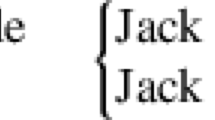Abstract
Are features on nouns associated with an interpretation? This is debated in the case of number, where some say that number features on nouns are interpreted, and others say that they are a mere reflex of an interpreted feature located elsewhere. This paper looks at gender features in Italian, where the gender a noun can have is not arbitrary, and it seeks to account for the restrictions that gender seems to impose on interpretation. It argues that gender features on Italian nouns are indeed associated with an interpretation. At the same time, however, there is a special process, subject to various conditions, that has the result that in certain contexts their contribution can be ignored. The paper thus defends a view on which interpretable elements can sometimes go uninterpreted. Gender features are among the elements that can do so.
Similar content being viewed by others
References
Beck S. (2000) Star Operators, episode 1: Defense of the double star. In: Kusumoto K., Villalta E. (eds) UMass occasional papers in linguistics 23: Issues in semantics. GLSA, Amherst, MA, pp 1–23
Corbett G. (1991) Gender. Cambridge University Press, Cambridge
Harris J. (1991) The exponence of gender in Spanish. Linguistic Inquiry 22(1): 27–62
Heim I., Kratzer A. (1998) Semantics in generative grammar. Blackwell, Malden, MA
Percus, O. (2006). Antipresuppositions. In A. Ueyama (Ed.), Theoretical and empirical studies of reference and anaphora: Toward the establishment of generative grammar as an empirical science. Report of the Grant-in-Aid for Scientific Research (B), Japan Society for the Promotion of Science. Accessible from the Semantics Archive. http://www.semanticsarchive.net.
Percus O. (2007) Interpretable but not interpreted. In: Aloni M., Dekker P., Roelofsen F. (eds) Proceedings of the sixteenth Amsterdam colloquium. ILLC/University of Amsterdam, Amsterdam
Riente L. (2002) Ladies first: The pivotal role of gender in the Italian nominal inflection system. In: Grüter T., Takehisa T. (eds) McGill working papers in linguistics 17.2. McGill University, Montreal
Sauerland U. (2003) A new semantics for number. In: Young R., Zhou Y. (eds) Proceedings of SALT 13. CLC Publications, Ithaca, pp 258–275
Sauerland, U. (2004). A comprehensive semantics for agreement. Ms., ZAS, Berlin. Accessible from Uli Sauerland’s ZAS web page, http://www.zas.gwz-berlin.de/home/sauerland/downloads.html.
Wechsler S., Zlatić L. (2003) The many faces of agreement. CSLI Publications, Stanford
Yatsushiro K., Sauerland U. (2006) [Feminine] in a high position. Snippets 6: 11
Zamparelli R. (2008) On the interpretability of phi-features. In: De Cat C., Demuth K. (eds) The Bantu-Romance connection. John Benjamins, Amsterdam, pp 167–199




